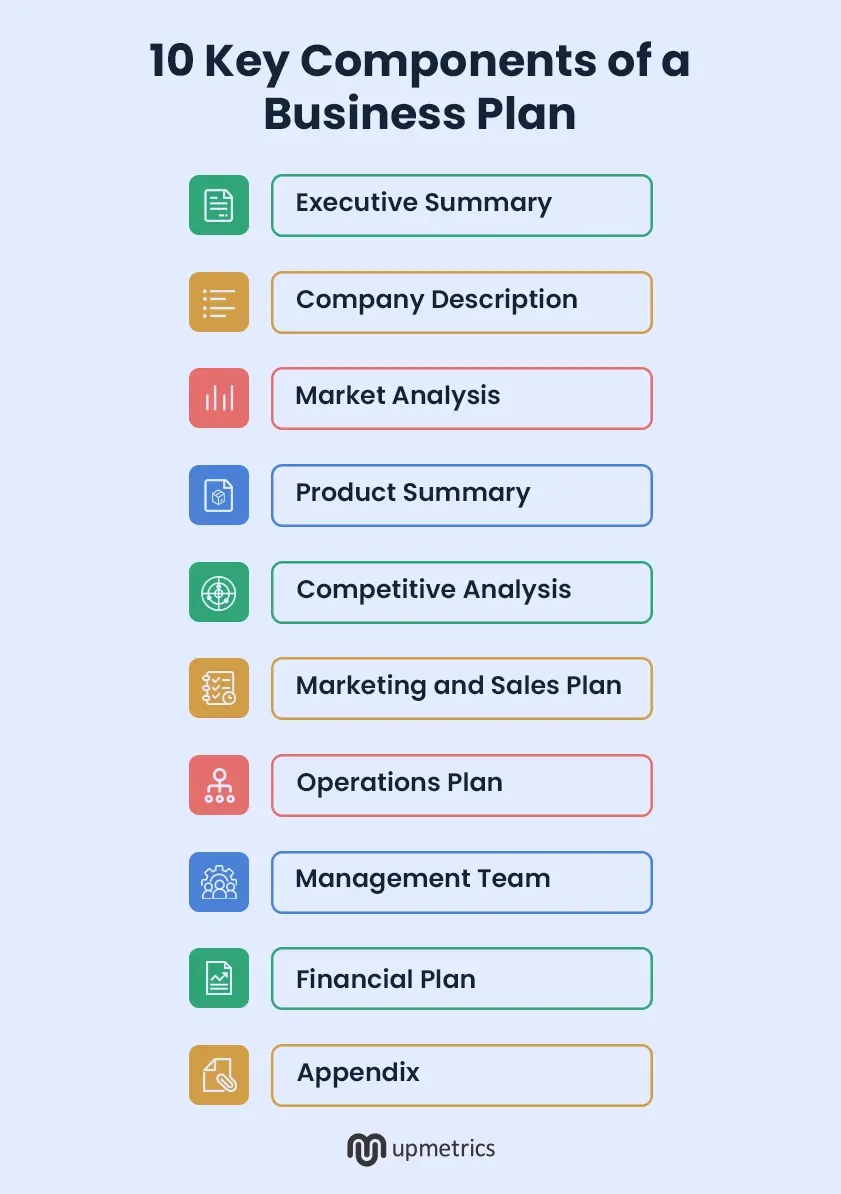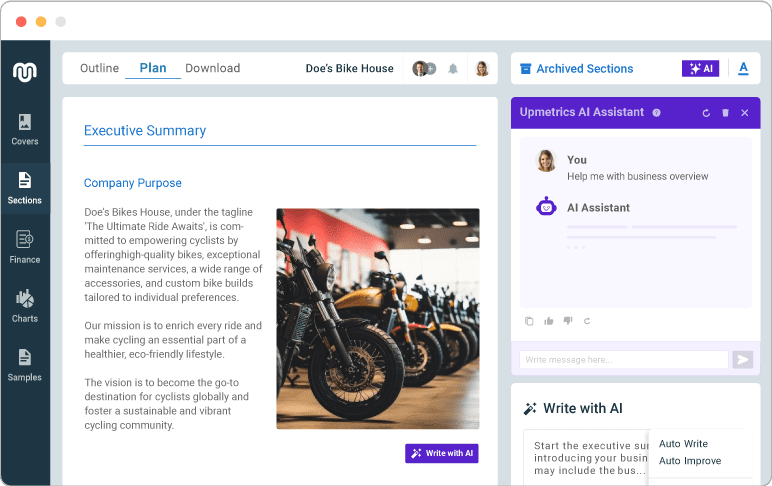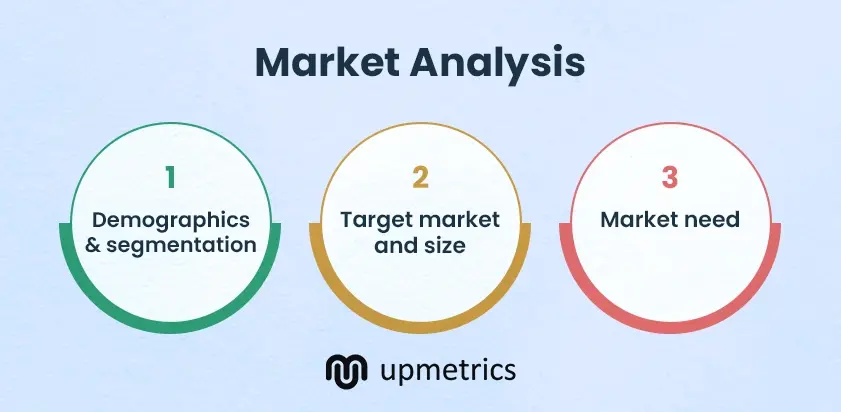Entrepreneurs who write a business plan are 16% more likely to achieve business viability than those who don’t.
More and more entrepreneurs are realizing this and are choosing to write a business plan that corresponds with their vision.
Whether you are writing a lean plan or a detailed, comprehensive plan, it must touch certain key points to aid in strategic decision-making and goal achievement.
Well, this blog post is here to help you. It talks about the 10 Business Plan Components that are quintessential for most plans.
So, without beating around the bush, let’s dive right in.
10 Essential Components of a Business Plan
A detailed, investor-ready business plan is divided into 10 sections. Even though each section serves a distinct purpose in its own way, when put together they form the holy document we call a business plan.
Let’s analyze and understand these different parts of a business plan.

1. Executive summary
The executive summary is one of the most important parts of a business plan. It’s the first thing potential investors will read and should therefore provide a clear overview of your business and its goals.
In other words, it helps the reader get a better idea of what to expect from your company. So, when writing an executive summary of your business, don’t forget to mention your mission and vision statement.
Mission statement
A mission statement is a brief statement that outlines your business objectives and what you want to achieve. It acts as a guiding principle that informs decisions and provides a clear direction for the organization to follow.
For instance, Google’s mission is to “organize the world’s information and make it universally accessible and useful.” It’s short, inspiring, and immediately communicates what the company does.
A mission statement should be realistic, and hint towards a goal that is achievable in a reasonable amount of time with the resources you currently have or are going to acquire in the near future.
Vision statement
While a mission statement is more actionable and has an immediate effect on the daily activities of the company, a vision statement is more aspirational and has a much broader scope.
Besides, a good executive summary might as well discuss key details about your business, like business name, history, a quick overview of your offerings, how much funding you need, and how you plan to use it.
A summary of your plan, in short.
2. Company description
The second component of your business plan is the company description. Here, you provide a brief overview of your company, its products or services, and its history. You can also add any notable achievements if they are significant enough for an investor to know.
Overview
A company overview offers a quick bird’s-eye view of things such as your business model, operational capabilities, financials, business philosophy, size of the team, code of conduct, and short-term and long-term objectives.
Products and services
The products and services part of your company description explains what your business offers to its customers, how it’s delivered, and the costs involved in acquiring new customers and executing a sale.
Company history
Company history is the timeline of important events for your business from its origin to the present day. It includes a brief profile of the founder(s) and their background, the date the company was founded, any notable achievements and milestones, and other similar facts and details.
If you’re a startup, you’ll probably not have much of a history to write about. In that case, you can share stories of the challenges your startup faced during its inception and how your team overcame them.

Pro-tip
Upmetrics’ AI Business Plan Generator
Using Upmetrics, you can now create a detailed business plan without having to worry about format or structure.
Simply answer a few business-related questions, and the plan generator will generate a detailed business plan including all the necessary components of an “ideal” business plan.

Upmetrics is a dedicated business planning tool built to save you time and frustration. It helps you build a complete, professional business plan—without bouncing across platforms.
- AI business plan generator: Answer a few quick questions and get a full draft in under 10 minutes, maintaining consistency across sections. Edit or modify anytime.
- Guided plan builder: Our plan builder guides you through the entire process of creating a business plan. Every section includes pointers and definitions to ensure clarity.
- Automated financial forecasting: AI assistance, built-in formulas, and a visual dashboard ensure accurate financial projections. No financial expertise needed.
- Collaborative workspaces: Collaborate with your team, partners, or advsiors to write your business plan. Upmetrics makes online collaboration and plan sharing easier.
3. Market analysis

The market analysis section of your business plan provides an in-depth analysis of the industry, target market, and competition. It should underline the risks and opportunities associated with your industry, and also comment on the attributes of your target customer.
Demographics and segmentation
Understanding the demographics of your customers plays a big role in how well you’re able to identify their traits and serve them.
By dividing your target audience into smaller and more manageable groups, you can tailor your services and products to better meet their needs.
You can use demographics such as age, gender, income, location, ethnicity, and education level to better understand the preferences and behaviors of each segment, and use that data to create more effective marketing strategies.
Target market and size
Understanding your target market lies at the core of all your marketing endeavors. After all, if you don’t have a clear idea of who you’re serving, you won’t be able to serve well, no matter how big your budget is.
For instance, Starbucks’ primary target market includes working professionals and office workers. The company has positioned itself such that many of its customers start their day with its coffee.
Estimating the market size helps you know how much scope there is to scale your business in the future. In other words, you’re trying to determine how much potential revenue exists in this market and if it’s worth the investment.
Market need
The next step is to figure out the market need, i.e., the prevalent pain points that people in that market experience. The easiest way to find these pain points is to read the negative reviews people leave on Amazon for products that are similar to yours.
The better your product solves those pain points, the better your chances of capturing that market. In addition, since your product is solving a problem that your rivals can’t, you can also charge a premium price.
To better identify the needs of your target customers, it helps to take into account things such as local cultural values, industry trends, buying habits, tastes and preferences, price elasticity, and more.
4. Product Summary
The product summary section of your business plan goes into detail about the features and benefits that your products and services offer, and how they differ from your competitors. It also outlines the manufacturing process, pricing, cost of production, inventory, packaging, and capital requirements.
5. Competitive analysis
Unless you’ve discovered an untapped market, you’re probably going to face serious competition and it’s only going to increase as you scale your business later down the line.
This is where the competitive analysis section helps. It gives an overview of the competitive landscape, introduces your direct and indirect competitors, and highlights their strengths and market share.
In such an environment, it helps to have certain competitive advantages against your rivals so you can stand out in the market.
Simply put, a competitive advantage is the additional value you can provide to your customers that your rivals can’t—perhaps via unique product features, excellent customer service, or more.

Want to Perform Competitive Analysis for Your Business?
Discover your competition’s secrets effortlessly with our user-friendly and Free Competitor Analysis Generator!
6. Marketing and sales plan

The marketing and sales plan is one of the most important business plan components. It explains how you plan to penetrate the market, position your brand in the minds of the buyers, build brand loyalty, increase sales, and remain competitive in an ever-changing business environment.
Unique selling proposition
A unique selling proposition (USP) conveys how your products and services differ from those of your competitors, and the added value those differences provide.
A strong USP will stand out in a competitive market and make potential customers more likely to switch to your brand—essentially capturing the market share of your rivals.
Marketing Plan
Your product might be unique, but if people don’t even know that it exists, it won’t sell. That’s where marketing comes in.
A marketing plan outlines strategies for reaching your target market and achieving sales goals. It also outlines the budget required for advertising and promotion.
You may also include data on the target market, target demographics, objectives, strategies, a timeline, budget, and the metrics considered for evaluating success.
Sales and distribution plan
Once people are made aware of your product, the next step is to ensure it reaches them. This means having a competent sales and distribution plan and a strong supply chain.
Lay out strategies for reaching potential customers, such as online marketing, lead generation, retail distribution channels, or direct sales.
Your goal here is to minimize sales costs and address the risks involved with the distribution of your product. If you’re selling ice cream, for example, you would have to account for the costs of refrigeration and cold storage.
Pricing strategy
Pricing is a very sensitive yet important part of any business. When creating a pricing strategy, you need to consider factors such as market demand, cost of production, competitor prices, disposable income of target customers, and profitability goals.
Some businesses have a small profit margin but sell large volumes of their product, while others sell fewer units but with a massive markup. You will have to decide for yourself which approach you want to follow.
Budget
Before setting your marketing plans into action, you need a budget for them. This means writing down how much money you’ll need, how it will be used, and the potential return you are estimating on this investment.
A budget should be flexible, meaning that it should be open to changes as the market shifts and customer behavior evolves. The goal here is to make sure that the company is making the best use of its resources by minimizing the wastage of funds.
Create winning Business Plans with our
AI Business Plan Generator
Plans starting from $14/month

7. Operations plan
The operations plan section of your business plan provides an overview of how the business is run and its day-to-day operations. This section is especially important for manufacturing businesses.
It includes a description of your business structure, the roles and responsibilities of each team member, the resources needed, and the procedures you will use to ensure the smooth functioning of your business. The goal here is to maximize output whilst minimizing the wastage of raw material or human labor.
8. Management team
At the core of any successful business lies a dedicated, qualified, and experienced management team overlooking key business activities.
This section provides an overview of the key members of your management team including their credentials, professional background, roles and responsibilities, experience, and qualifications.
A lot of investors give special attention to this management team section as it helps them ascertain the competence and work ethic of the members involved.
Organizational structure
An organizational structure defines the roles, responsibilities, decision-making processes, and authority of each individual or department in an organization.
Having a clear organizational structure improves communication, increases efficiency, promotes collaboration, and makes it easier to delegate tasks.
Startups usually have a flatter organizational hierarchy, whereas established businesses have a more traditional structure of power and authority.
9. Financial Plan
Financials are usually the least fun thing to talk about, but they are important nonetheless, as they provide an overview of your current financial position, capital requirements, projections, and plans for repayment of any loans.
A financial plan mainly includes detailed financial statements and a funding overview. Let’s check these components.
Financial statements
A business plan should include detailed financial projections for the next couple of years. An investor would likely require an income statement, cash flow statement, balance sheet, and break-even analysis to understand the profitability, growth, and revenue of your business.
Along with your financial statements, you should also include an analysis of your startup costs, operating and administration costs, and forecasted sales.
Present these statements visually to make your financial plan easy to digest.
Funding requirements
Once an investor has read through your business plan, it’s time to request funding. Investors will want to see an accurate and detailed breakdown of the funds required and an explanation of why the requested funds are necessary for the operation and expansion of your business.
10. Appendix
The appendix is the last section of your business plan that includes additional supporting documents such as resumes of key team members, market research documents, financial statements, and legal documents.
In other words, anything important or relevant that couldn’t fit in any of the former sections of your business plan goes in the appendix.
And those are the essential business plan components you need to include in your plan.
Write your Business Plan with Upmetrics
A well-written business plan is an asset that navigates the business risks, optimizes the business strategies, and serves as a roadmap to help you achieve your business objectives.
Think about it and you will realize that the benefits of having a detailed business plan are ample. However, writing a business plan that covers these essential components and that too from scratch is a bit excessive.
Don’t worry. Using the Upmetrics business planning app you can streamline your planning process and create a detailed business plan in about 10 minutes.
Ready to create your plan?

